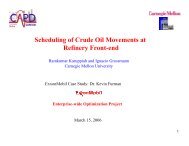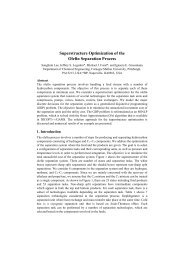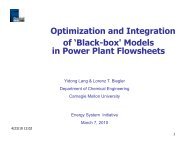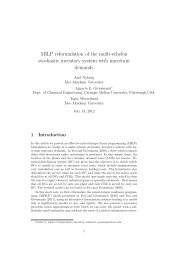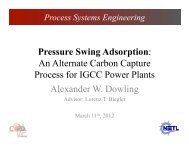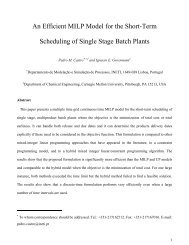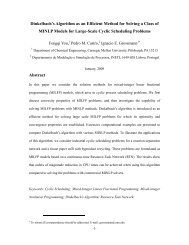Modeling of Purchase and Sales Contracts in Supply Chain ...
Modeling of Purchase and Sales Contracts in Supply Chain ...
Modeling of Purchase and Sales Contracts in Supply Chain ...
You also want an ePaper? Increase the reach of your titles
YUMPU automatically turns print PDFs into web optimized ePapers that Google loves.
1 IntroductionIf we exam<strong>in</strong>e the ever <strong>in</strong>creas<strong>in</strong>g amount <strong>of</strong> literature on problems belong<strong>in</strong>g to the operation plann<strong>in</strong>g<strong>of</strong> production plants <strong>and</strong> <strong>Supply</strong> Cha<strong>in</strong> Management (SCM), it can be found that there are still manyissues related to the management <strong>of</strong> the relationships between a company’s <strong>Supply</strong> Cha<strong>in</strong> (SC) <strong>and</strong> itscustomers <strong>and</strong> suppliers. Particularly, the sign<strong>in</strong>g <strong>of</strong> contracts is a common practice <strong>in</strong> the bus<strong>in</strong>essworld, through which the company aims ma<strong>in</strong>ly for two objectives: to reduce uncerta<strong>in</strong>ty by plann<strong>in</strong>gcapacity <strong>and</strong> ensur<strong>in</strong>g a certa<strong>in</strong> sales level, <strong>and</strong> to take advantage <strong>of</strong> the discounts for purchas<strong>in</strong>gmaterials <strong>in</strong> large amounts (economies <strong>of</strong> scale). For example, on review<strong>in</strong>g the advances <strong>and</strong>challenges <strong>in</strong> SCM, Shah (2005) 1 identifies the negotiation <strong>of</strong> long-term contracts as an important SCMproblem at a strategic level.A contract can be understood as a b<strong>in</strong>d<strong>in</strong>g agreement <strong>in</strong> which the seller provides the specified product<strong>and</strong> the buyer pays for it under specific terms <strong>and</strong> conditions. Current approaches for productionplann<strong>in</strong>g at different levels <strong>of</strong>ten neglect this important aspect focus<strong>in</strong>g on other issues 2 . Therefore, <strong>in</strong>this work, we propose the model<strong>in</strong>g <strong>of</strong> several types <strong>of</strong> contracts with the external entities <strong>of</strong> thecompany, both suppliers <strong>and</strong> customers, which gives the opportunity <strong>of</strong> improv<strong>in</strong>g these approaches.The paper is organized as follows. First, a literature review on recent work about contract model<strong>in</strong>g ispresented. Next, the problem is described as well as the proposed models for process network withextensions to allow for contracts. These models are solved bye means <strong>of</strong> disjunctive programm<strong>in</strong>g(Grossmann <strong>and</strong> Lee (2003) 3 ). The performance <strong>of</strong> the models is then illustrated through two examples<strong>and</strong> f<strong>in</strong>ally, the results obta<strong>in</strong>ed are discussed <strong>and</strong> some guidel<strong>in</strong>es for future work are <strong>in</strong>dicated.2 Literature reviewLiterature on contracts, <strong>in</strong> the area <strong>of</strong> SCM, may be divided <strong>in</strong> three areas: negotiation process,uncerta<strong>in</strong>ty management <strong>and</strong> contract model<strong>in</strong>g.2
The negotiation process is an area ma<strong>in</strong>ly belong<strong>in</strong>g to the field <strong>of</strong> Computers Science <strong>in</strong> which theemphasis is placed on the contract negotiation process itself. Many <strong>of</strong> these works are related to the e-commerce <strong>and</strong> s<strong>of</strong>tware agents on the web. With<strong>in</strong> this area, a number <strong>of</strong> different negotiable attributes,e.g. prices, quantities, due-dates, etc., are calculated by means <strong>of</strong> auction-like processes between the<strong>in</strong>terested parties. Such systems are simulators that mimic the negotiation process until reach<strong>in</strong>g anagreement <strong>in</strong> the contractual conditions (S<strong>and</strong>holm (2002) 4 ). Goodw<strong>in</strong> et al. (1999) 5present aframework for provid<strong>in</strong>g decision support for an on-l<strong>in</strong>e exchange. They use a multi-agent system t<strong>of</strong><strong>in</strong>d matches <strong>of</strong> dem<strong>and</strong> <strong>and</strong> supply on the exchange <strong>and</strong> provide the user with the best set <strong>of</strong>transactions. The user then chooses the best match based on his/her discretion.Most works devoted to uncerta<strong>in</strong>ty management apply an adapter strategy <strong>in</strong> which the companycontrols the risk exposure <strong>of</strong> its assets by constantly adapt<strong>in</strong>g its operations to unfold<strong>in</strong>g dem<strong>and</strong>realizations. In contrast, <strong>in</strong> the strategy known as shaper the SC aims to restructure the dem<strong>and</strong>distribution contract<strong>in</strong>g agreements with the customer (Anup<strong>in</strong>di <strong>and</strong> Bassok (1999) 6 ). Some <strong>of</strong> theseworks are aimed at demonstrat<strong>in</strong>g how contracts are an effective tool aga<strong>in</strong>st dem<strong>and</strong> <strong>and</strong> supplyuncerta<strong>in</strong>ty. They are based on stochastic programm<strong>in</strong>g <strong>and</strong> use risk measures to compare theapproaches with <strong>and</strong> without sign<strong>in</strong>g up contracts. Nevertheless, these works do not put the emphasis onmodel<strong>in</strong>g the type <strong>of</strong> contracts, <strong>in</strong> fact, contract models are rather simple because they consist <strong>of</strong><strong>in</strong>clud<strong>in</strong>g fixed quantities at given times <strong>in</strong> the horizon <strong>of</strong> the analysis.A type <strong>of</strong> contract that is extensively used <strong>in</strong> these works is the option contract (Hull (1995) 7 ). Options,also known as derivative securities or cont<strong>in</strong>gent claims, are legally b<strong>in</strong>d<strong>in</strong>g <strong>and</strong> negotiable contractsthat give the holder the right, but not the obligation, to purchase a certa<strong>in</strong> quantity <strong>of</strong> an agricultural,<strong>in</strong>dustrial, or f<strong>in</strong>ancial product at a specified price <strong>and</strong> time for a one-time, upfront premium payment.Applications <strong>in</strong> this direction can be found <strong>in</strong> the works by Gupta <strong>and</strong> Maranas (2003) 8 , Barbaro <strong>and</strong>Bagajewicz (2004) 9 , Bonfill et al. (2004) 10 <strong>and</strong> Aseeri <strong>and</strong> Bagajewicz (2004) 11 .A different aspect with<strong>in</strong> the area <strong>of</strong> contracts is the model<strong>in</strong>g <strong>of</strong> different types <strong>of</strong> contracts that acompany can set up dur<strong>in</strong>g its plann<strong>in</strong>g process. The consequence <strong>of</strong> this is the modification <strong>of</strong> the3
objective function <strong>of</strong> the correspond<strong>in</strong>g optimization program result<strong>in</strong>g <strong>in</strong> a more complex but also morerealistic cost function. There has been little work done <strong>in</strong> this area <strong>and</strong> the one that has been reported byKallrath (2002) 12 , Schulz et al. (2005) 13 <strong>and</strong> Ch<strong>and</strong>ra et al. (2004) 14 assumes that types <strong>of</strong> contracts aregiven <strong>and</strong> not decision variables.3 Problem statementIn this paper, we consider short <strong>and</strong> long-term multiperiod production plann<strong>in</strong>g <strong>of</strong> a chemical supplycha<strong>in</strong> network. The network <strong>in</strong>volves NP processes, NC chemicals for which NI <strong>in</strong>ventories are keptover NT time periods. The operation <strong>of</strong> the network is constra<strong>in</strong>ed by exist<strong>in</strong>g capacities <strong>of</strong> all processes<strong>in</strong> the network, limits <strong>in</strong> the supplies <strong>of</strong> raw materials <strong>and</strong> market saturation <strong>of</strong> some products.Information is given for different types <strong>of</strong> contracts that can be made for purchas<strong>in</strong>g raw materials <strong>and</strong>sell<strong>in</strong>g the products. The objective <strong>in</strong> the short-term plann<strong>in</strong>g problem is to determ<strong>in</strong>e over a given timehorizon, typically weeks or months, the types <strong>of</strong> contracts for the purchase <strong>of</strong> raw materials <strong>and</strong> sales <strong>of</strong>products <strong>in</strong> order to maximize the pr<strong>of</strong>it, which can be calculated by the data on sales revenues,operat<strong>in</strong>g costs, market<strong>in</strong>g costs, <strong>in</strong>ventory cost <strong>and</strong> shortfall penalties. For the case <strong>of</strong> the long-termplann<strong>in</strong>g problem, we consider the possible capacity expansion <strong>of</strong> the processes. In this case, weaccount for the capital costs <strong>in</strong> the NPV but exclude the effect <strong>of</strong> <strong>in</strong>ventories s<strong>in</strong>ce the length <strong>of</strong> the timeperiods are assumed to be large (e.g. one year each). Our goal is to decide (a) which contract to make <strong>in</strong>the purchase <strong>of</strong> the raw materials <strong>and</strong> sell<strong>in</strong>g the products <strong>in</strong> each time period, <strong>and</strong> (b) whether capacity<strong>of</strong> each process should be exp<strong>and</strong>ed or not <strong>in</strong> each time period.We consider various models for the supply/dem<strong>and</strong> that <strong>in</strong>volve different contract types which <strong>in</strong>cludevarious types <strong>of</strong> discounts depend<strong>in</strong>g on the volumes <strong>and</strong> lengths <strong>of</strong> contracts. We will assume that allthe <strong>in</strong>formation is available <strong>in</strong> order to formulate the problem as a multiperiod MILP model.3.1 Contract models for supply4
Discount after a certa<strong>in</strong> amount:The cost <strong>of</strong> purchas<strong>in</strong>g raw materials <strong>in</strong> the discount after a certa<strong>in</strong> amount (see Figure 1) is given by:COSTdjtd1d1d 2 d 2= ϕ P + ϕ P j ∈ JR,t ∈T(2)jtjtjtjtd1d 2⎡y⎤ ⎡y⎤jtjt⎢⎥ ⎢ ⎥d1d d1d⎢0≤ Pjt≤ σjt ⎥ ∨ ⎢Pjt= σjt ⎥ j ∈ JR,t ∈T(3)⎢d 2⎥ ⎢d 2⎥⎢⎣Pjt= 0 ⎥⎦⎢⎣Pjt≥ 0 ⎥⎦Pdjtd1d 2= P + P j ∈ JR,t ∈Tjtjt(4)d1 d 2where ϕ > ϕ .jtjtIn this contract, if the amount <strong>of</strong> raw material required isdσjt<strong>of</strong> raw materials at the price <strong>of</strong>Otherwise (d1ϕjt<strong>and</strong> an excess amount,y d 1jt= true ), we buy raw materials at the price <strong>of</strong>d 2Pjtwhich exceedsPd 2jtdjtσ ( y d 2jt= true ), we buydjt−σ, at the lower price,d1ϕjtwhich is higher th<strong>and</strong> 2ϕjt.d 2ϕjt.Bulk discount:Figure 2. Bulk discount.The cost <strong>of</strong> purchas<strong>in</strong>g raw materials <strong>in</strong> the bulk discount (see Figure 2) is given by:b1b2⎡y⎤ ⎡y⎤jtjt⎢⎥ ⎢⎥b b1bb b2b⎢COSTjt= ϕjtPjt⎥ ∨ ⎢COSTjt= ϕjtPjt⎥⎢b b⎥ ⎢b b⎥⎢⎣0 ≤ Pjt≤ σjt ⎥⎦⎢⎣Pjt≥ σjt ⎥⎦j ∈ JR,t ∈T(5)6
2In the bulk discount contract, we buy the entire amount <strong>of</strong> raw materials at the lower price ϕjtif thebamount <strong>of</strong> raw materials we buy is greater than σjt. Otherwise, <strong>in</strong> this contract we purchase the rawb1material at the higher price ϕjt.Fixed duration contract:The fixed duration contract specifies the length <strong>of</strong> the time that contracts are valid <strong>and</strong> the m<strong>in</strong>imumquantity that must be purchased. For example, the 1-month contract specifies no m<strong>in</strong>imum amount atthe current price ( ϕ ) <strong>and</strong> lasts for 1 month. The 2-month contract specifies a m<strong>in</strong>imum purchasejtl1jt2quantity ( σ l ) <strong>and</strong> the purchase price ( ϕ ) which is lower thanl 2jtl1ϕjtfor the 2 months. The 3-monthcontract specifies the m<strong>in</strong>imum quantity ( σ ) <strong>and</strong> the purchase price ϕ 3 which is lower than ϕ2l3jtdur<strong>in</strong>g the 3 months. In fixed duration contracts, the longer the contracts last, the larger the m<strong>in</strong>imuml 2 l3l1 l 2 l3purchase quantities per month ( 0 < σ < σ ) are, but the lower the purchase prices ( ϕ > ϕ > ϕ )jtare. Figure 3 shows how each contract lasts dur<strong>in</strong>g a given number <strong>of</strong> periods.jtl jtjtjtjtl jtFigure 3. Fixed duration contracts.The cost <strong>of</strong> purchas<strong>in</strong>g raw materials <strong>in</strong> the fixed length contract, assum<strong>in</strong>g up to 3 time periodscontract for simplicity, is given by:7
l3⎡y⎤jt⎢⎥l 2l l3l⎡y⎤jt⎢COSTjt= ϕjtPjt⎥⎢⎥l1l l 2 l⎢l l3l⎥⎡y⎤jt⎢COSTjt= ϕjtPjt⎥ ⎢COSTj,t+1= ϕjtPj, t+1 ⎥⎢⎥l l1l⎢l l 2 l⎥ ⎢ l l3l ⎥⎢COSTjt= ϕjtPjt⎥ ∨ ⎢COSTj,t+ 1= ϕjtPj, t+1⎥∨ ⎢COSTj,t+2= ϕjtPj, t+2 ⎥ j ∈ JR,t ∈T(6)⎢l l1⎥ ⎢ l l 2 ⎥ l lPjtjtP⎢3jt jtP⎥⎢⎣≥ σ ⎥⎦⎢ ≥ σ⎥ ⎢jt≥ σjt⎥⎢ l l 2l lP⎥ ⎢3j t jtP⎥⎣ , + 1≥ σ ⎦ j,t+1≥ σjt⎢⎥l l3⎢P⎥⎣ j,t+2≥ σjt ⎦3.2 Contract models for dem<strong>and</strong>Concern<strong>in</strong>g the contracts with the customers, we also consider the four cases mentioned above. A fixedprice contract means that we sell products <strong>in</strong> some amount with the current market price. The revenues<strong>of</strong> sell<strong>in</strong>g products <strong>in</strong> the fixed price contract are given by:REVfjtf f= ψ S j ∈ JP,t ∈T(7)jtjtwherefψjtis the contract price <strong>of</strong> product j at time period t <strong>and</strong>fSjtis the amount <strong>of</strong> j sold at timeperiod t . The superscript st<strong>and</strong>s for the type <strong>of</strong> contract, fixed price contract <strong>in</strong> this case.The <strong>in</strong>come for sell<strong>in</strong>g products <strong>in</strong> the discount after certa<strong>in</strong> amount is given by:REVdjtd1d1d 2 d 2= ψ S + ψ S j ∈ JP,t ∈T(8)jtjtjtjtd1d 2⎡z⎤ ⎡z⎤jtjt⎢⎥ ⎢ ⎥d1d d1d⎢0≤ Sjt≤ ρjt ⎥ ∨ ⎢Sjt= ρjt ⎥ j ∈ JP,t ∈T(9)⎢d 2⎥ ⎢d 2⎥⎢⎣Sjt= 0 ⎥⎦⎢⎣Sjt≥ 0 ⎥⎦Sdjtd1d 2= S + S j ∈ JP,t ∈Tjtjt(10)d1 d 2dwhere ψjt> ψjtare the two different prices <strong>of</strong> product j <strong>and</strong> ρjtis the m<strong>in</strong>imum amount that isnecessary to sell to give the discount.Also similarly to the contract with the suppliers, the revenues <strong>of</strong> sell<strong>in</strong>g products <strong>in</strong> the bulk discountmanner are given by:8
4 LP <strong>and</strong> MILP models for process networkIn this section, we consider two types <strong>of</strong> optimization models for process network, for the short-termplann<strong>in</strong>g problem <strong>and</strong> for the long-term plann<strong>in</strong>g problem. In the short-term plann<strong>in</strong>g problem weconsider the schedule <strong>of</strong> purchase <strong>of</strong> raw materials from suppliers, production <strong>of</strong> products <strong>of</strong> eachprocess with fixed capacity, <strong>in</strong>ventories <strong>of</strong> each product, <strong>and</strong> sales <strong>of</strong> products. In the long-termplann<strong>in</strong>g problem we consider the optimal selection <strong>and</strong> expansion <strong>of</strong> processes given time vary<strong>in</strong>gforecasts for the dem<strong>and</strong>s <strong>and</strong> prices <strong>of</strong> chemicals over a long time horizon.4.1 Short-term plann<strong>in</strong>g modelThe objective function to be maximized is the operat<strong>in</strong>g pr<strong>of</strong>it <strong>of</strong> the network over a short-term horizon(e.g. several months) consist<strong>in</strong>g <strong>of</strong> a set <strong>of</strong> time periods dur<strong>in</strong>g which prices <strong>and</strong> dem<strong>and</strong>s <strong>of</strong> chemicals<strong>and</strong> costs <strong>of</strong> operat<strong>in</strong>g <strong>and</strong> <strong>in</strong>ventory can vary. The operat<strong>in</strong>g costs for each process are assumed to beproportional to the flow <strong>of</strong> the ma<strong>in</strong> product. The short-term plann<strong>in</strong>g model is formulated as amultiperiod LP problem. The <strong>in</strong>dices, sets, parameters, <strong>and</strong> variables def<strong>in</strong>ed <strong>in</strong> the model are given <strong>in</strong>the Nomenclature section.In the short-term plann<strong>in</strong>g model, the operat<strong>in</strong>g pr<strong>of</strong>it is given by P1:PROFIT =−∑∑j∈Jt∈Tψ Sjt∑∑∑i∈Ij∈JMt∈Tijt−δ Wit∑∑j∈Jt∈Tijt−ϕ Pjt∑∑j∈Jt∈Tjtξ Vjtjt−∑∑j∈Jt∈Tθ SFjtjt(13)where each term accounts for <strong>in</strong>come from sales, purchase cost, operat<strong>in</strong>g cost, <strong>in</strong>ventory cost, <strong>and</strong>shortfall cost, respectively. We can additionally def<strong>in</strong>eCOSTjt= ϕjtPjt<strong>and</strong> REVjtψjtSjt= whichrespectively represents purchases <strong>and</strong> sales <strong>and</strong> will be def<strong>in</strong>ed later to account for different contracts.The amount <strong>of</strong> chemical j be<strong>in</strong>g consumed or produced <strong>in</strong> process i dur<strong>in</strong>g period t is represented bythe variables:Wijt≥ 0 i ∈ I,j ∈ J , t ∈T(14)iwhere Jiis the set <strong>of</strong> chemicals <strong>in</strong>volved by process i .10
All chemical flows <strong>in</strong> process i other than the ma<strong>in</strong> product are given by the mass balance coefficients.The follow<strong>in</strong>g equation relates the <strong>in</strong>put to the output <strong>of</strong> processes:Wijt= µ W i ∈ I,j ∈ J , j'∈ JM , t ∈T(15)ijij'tiiwhereeach process i .JMiis the set <strong>of</strong> ma<strong>in</strong> products <strong>of</strong> process i , <strong>and</strong> µ ijare positive constants characteristic <strong>of</strong>The amount produced by process i cannot exceed the <strong>in</strong>stalled capacity:Wijt≤ Q i ∈ I, j ∈ JM , t ∈T(16)itiAs for the raw materials, <strong>in</strong>termediates <strong>and</strong> products, they are expressed by NC nodes <strong>of</strong> chemicalswhere purchases <strong>and</strong> sales are considered on s<strong>in</strong>gle market. They must satisfy the <strong>in</strong>equalities:adLjtLjt≤ P≤ Sjtjt≤ aUjt≤ dUjt⎪⎫⎬⎪⎭j ∈ J, t ∈T(17)whereLajt,bounds on the dem<strong>and</strong>s.Uajtare lower <strong>and</strong> upper bounds on the availabilities, <strong>and</strong> d L jt,11Udjtare lower <strong>and</strong> upperEquation (18) corresponds to the mass balance <strong>of</strong> chemical j <strong>in</strong> the network which <strong>in</strong>cludes the<strong>in</strong>ventory levelsVjt:Vj, t− 1+ ∑Wijt+ Pjt= Vjt+ ∑Wijt+ Sjtj ∈ J,t ∈T(18)wherei∈Oji∈IjOjis def<strong>in</strong>ed as the set <strong>of</strong> processes that produce chemical j <strong>and</strong> Ijas the set <strong>of</strong> processes thatconsume chemical j .Production shortfalls with respect to the dem<strong>and</strong>s (equation (19)) compensate loss <strong>of</strong> potential saleswhich is penalized <strong>in</strong> the objective function, equation (13).SFU≥ d − S j ∈ J, t T(19)jt jt jt∈U0 ≤ SF ≤ SF j ∈ J,t ∈T(20)jtjtF<strong>in</strong>ally, equations (21) <strong>and</strong> (22) represent the upper or lower bounds for each variable.
VjtU≤ V j ∈ J, t ∈T(21)jtS , P , W , V ≥ 0(22)jtjtitjt4.2 Long-term plann<strong>in</strong>g modelIn the long-term plann<strong>in</strong>g model, we consider the network which <strong>in</strong>cludes an exist<strong>in</strong>g system as well aspotential new processes <strong>and</strong> chemicals. Also, a f<strong>in</strong>ite number <strong>of</strong> time periods is considered dur<strong>in</strong>g whichprices <strong>and</strong> dem<strong>and</strong>s <strong>of</strong> chemicals, <strong>and</strong> <strong>in</strong>vestment <strong>and</strong> operat<strong>in</strong>g costs <strong>of</strong> the processes can vary. Theobjective function to be maximized is the net present value <strong>of</strong> the project over the specified horizon <strong>in</strong>order to determ<strong>in</strong>e the capacity expansion for exist<strong>in</strong>g processes <strong>and</strong> sales <strong>and</strong> purchases <strong>of</strong> chemicals ateach time period. This problem therefore becomes a multiperiod MILP model.Similarly as <strong>in</strong> the short term plann<strong>in</strong>g model, l<strong>in</strong>ear models are assumed for the mass balances <strong>in</strong> theprocesses, while fixed-charge cost models are used for the <strong>in</strong>vestment cost. Also, limits on the<strong>in</strong>vestment cost at each time period can be specified, as well as constra<strong>in</strong>ts on the sales <strong>and</strong> purchases.No <strong>in</strong>ventories will be considered s<strong>in</strong>ce the length <strong>of</strong> each time period is assumed to be rather long (e.g.1 year).In the formulation <strong>of</strong> this problem, variable Q itrepresents the total capacity <strong>of</strong> process i that isavailable <strong>in</strong> period t ,t = 1,K,T . Parameter Qi0represents the exist<strong>in</strong>g capacity <strong>of</strong> a process at timet = 0 . Variable QEitrepresents the capacity expansion <strong>of</strong> process i which is <strong>in</strong>stalled <strong>in</strong> period t . Ifare the 0-1 b<strong>in</strong>ary variables which <strong>in</strong>dicate the occurrence <strong>of</strong> the expansions for each process i at eachtime period t , the constra<strong>in</strong>ts that apply are:witQEwitLitwit∈{0,1}≤ QEit≤ QEUitwit⎫⎬⎭i ∈ I,t ∈T(23)Qit= Q, − 1+ QE i ∈ I,t ∈T(24)i titIn equation (23),LQEit<strong>and</strong>UQEitare lower <strong>and</strong> upper bounds for the capacity expansions. A zero-value<strong>of</strong> the b<strong>in</strong>ary variables w itmakes the capacity expansion at period t zero, QEit= 0 . If the b<strong>in</strong>ary12
variable is equal to one, the capacity expansion is implemented. Equation (24) simply def<strong>in</strong>es the totalcapacityQitthat is available at each time period t . Equations (14)-(17) are also considered asconstra<strong>in</strong>ts.WWWijtijtijt≥ 0 i ∈ I,j ∈ J , t ∈T(14)i= µ W i ∈ I,j ∈ J , j'∈ JM , t ∈T(15)ijij'tii≤ Q i ∈ I, j ∈ JM , t ∈T(16)itiadLjtLjt≤ P≤ Sjtjt≤ aUjt≤ dUjt⎪⎫⎬⎪⎭j ∈ J, t ∈T(17)Equation (18) is modified <strong>in</strong>to equation (25) s<strong>in</strong>ce there <strong>in</strong> no <strong>in</strong>ventory <strong>in</strong> this problem.∑i∈OjWijt+ Pjt= ∑Wi∈Ijijt+ Sjtj ∈ J, t ∈T(25)F<strong>in</strong>ally, the objective function is given by P2:NPV=−∑∑j∈Jt∈Tψ Sjt∑∑∑i∈Ij∈JMt∈Tijtit−δ W∑∑j∈Jt∈Tijt−ϕ P∑∑( αitQEit+ βitwit)i∈Ijtt∈Tjt(26)whereψjt, ϕjtare the prices <strong>of</strong> sales <strong>and</strong> purchases <strong>of</strong> the chemical j , δitis the unit operat<strong>in</strong>g cost,<strong>and</strong> parameters α it,βitexpress the variable <strong>and</strong> fixed terms for the <strong>in</strong>vestment cost, respectively. Allthese parameters are discounted at the specific <strong>in</strong>terest rate <strong>and</strong> <strong>in</strong>clude the effects <strong>of</strong> taxes <strong>and</strong>depreciations <strong>in</strong> the net present value.In order to determ<strong>in</strong>e the optimal plann<strong>in</strong>g <strong>of</strong> the network, the multiperiod MILP model consists <strong>of</strong>maximiz<strong>in</strong>g the NPV <strong>in</strong> equation (26), subject to constra<strong>in</strong>ts (14)-(17) <strong>and</strong> (23)-(25).We consider additional constra<strong>in</strong>ts that <strong>in</strong>clude limits on the number <strong>of</strong> expansions <strong>of</strong> each process <strong>in</strong>equation (27) <strong>and</strong> limit on the capital for <strong>in</strong>vestment dur<strong>in</strong>g each time <strong>in</strong> equation (28).∑ wit≤ NEXP( i)i ∈ I(27)t13
∑i∈I( α itQE+ β w ) ≤ CI(t)t ∈T(28)whereitα it ,ititβitare nondiscounted cost coefficients with regard to period t .4.3 Extension for contract modelsWe modify problem P1 <strong>in</strong> order to consider contract models mentioned <strong>in</strong> a previous section. For thispurpose we assume that we can purchase the raw materials from suppliers with any <strong>of</strong> the few types <strong>of</strong>contracts at each time t (see Figure 4).Figure 4. <strong>Purchase</strong> <strong>of</strong> raw materials with several contracts.The objective function <strong>in</strong> P1 changes as follows,PROFIT =−∑∑j∈Jt∈Tψ Sjt∑∑∑i∈Ij∈JMit∈Tjt−δ Wit∑∑∑c∈Cj∈Jt∈Tijt−∑∑j∈Jt∈TCOSTξ Vjtcjtjt−∑∑j∈Jt∈Tθ SFjtjt(29)whereas the correspond<strong>in</strong>g one for P2 is:NPV=−∑∑j∈Jt∈Tψ Sjt∑∑∑i∈Ij∈JMit∈Tjtit−δ W∑∑j∈Jt∈Tijt−∑∑( αitQEit+ βitwit)i∈ICOSTt∈Tcjt(30)wherecCOSTjtrepresents the cost <strong>of</strong> purchas<strong>in</strong>g raw materials j at time horizon t under contract c .Below we provide constra<strong>in</strong>ts to determ<strong>in</strong>e costs for each type <strong>of</strong> contract (see Figure 4).COSTjt= ∑COSTc∈Ccjtj ∈ JR, t ∈T(31)f d b lP = P + P + P + P j ∈ JR, t ∈T(32)jtjtjtjtjt14
c c0 ≤ P ≤ Uy c ∈C,j ∈ JR,t ∈T(33)jtjt∑c∈Cycjt≤1 j ∈ JR,t ∈T(34)y ∈{0,1} , c ∈ C = { f , d,b,l}cjtCOSTjt, the cost <strong>of</strong> purchas<strong>in</strong>g raw material j at time horizon t , is def<strong>in</strong>ed as the summation <strong>of</strong>cCOSTjt,c = f , d,b,l , <strong>and</strong> Pjt, the amount <strong>of</strong> raw material j purchased at time horizon t , is alsodef<strong>in</strong>ed as the summation <strong>of</strong>P <strong>in</strong> equations (30) <strong>and</strong> (31), respectively. The variables P c have thecjtjtupper <strong>and</strong> lower bounds <strong>in</strong> equation (32). We use the 0-1 b<strong>in</strong>ary variables that decide the contract tomake. We assume that for each chemical j , the number <strong>of</strong> contracts that can be made at time t must beequal or less than one at each time period t .For the fixed price, the purchas<strong>in</strong>g cost is simply equation (1).COSTfjtf f= ϕ P j ∈ JR,t ∈T(1)jtjtFor the disjunctions under contracts <strong>of</strong> the discount after certa<strong>in</strong> amount, the bulk discount <strong>and</strong> thelength contract (equations (2)-(6)), the convex hull formulation by Balas (1985) 15 is used to convertthese disjunctions <strong>in</strong>to an MILP.Firstly, we consider the disjunction <strong>in</strong> equation (3) under the discount after certa<strong>in</strong> amount. To obta<strong>in</strong>the convex hull <strong>of</strong> equation (3), the cont<strong>in</strong>uous variableseach disjunction <strong>in</strong> equation (36).d1Pjtare disaggregated, creat<strong>in</strong>g a variable forCOSTdjtd1d1d 2 d 2= ϕ P + ϕ P j ∈ JR,t ∈T(35)jtjtjtjtPdjtd1d 2= P + P j ∈ JR,t ∈Tjtjt(36)Pd1jtd11d12= P + P j ∈ JR,t ∈Tjtjt(37)d11d1d0 ≤ P ≤ y σ j ∈ JR,t ∈T(38)jtjtjtPd12jtd 2 d= y σ j ∈ JR,t ∈T(39)jtjt15
d 2 d 2 d0 ≤ P ≤ y U j ∈ JR,t ∈Tyd1jtjtjtjtd 2 d+ y = y j ∈ JR,t ∈Tjtjt(40)(41)yd1jt, yd 2jt∈{0,1}Variable bounds <strong>and</strong> modification equations are now rewritten <strong>in</strong> terms <strong>of</strong> the disaggregated <strong>and</strong> b<strong>in</strong>aryvariables (equations (37), (38) <strong>and</strong> (39)). In case the discount contract is selected,dyjtis one, equation(40) enforces the requirement that only one b<strong>in</strong>ary variable be activated depend<strong>in</strong>g on the amountthat is purchased.Secondly, we consider the disjunction <strong>in</strong> equation (5) under the contract <strong>of</strong> bulk discount. Apply<strong>in</strong>g theconvex hull to this equation yields the follow<strong>in</strong>g constra<strong>in</strong>ts:dσjtCOSTbjtb1b1b2b2= ϕ P + ϕ P j ∈ JR,t ∈T(42)jtjtjtjtPbjtb1b2= P + P j ∈ JR,t ∈Tjtjt(43)b1b b10 ≤ P ≤ σ y j ∈ JR,t ∈T(44)jtjtjtb b2b2b bσ y ≤ P ≤ U y2 j ∈ JR,t ∈T(45)jtjtjtjtjtyb1jtb2b+ y = y j ∈ JR,t ∈Tjtjt(46)yb1jt, yb2jt∈{0,1}In the fixed length contract, we convert the disjunctions <strong>in</strong> equation (6) <strong>in</strong>to the MILP constra<strong>in</strong>ts asfollows.COSTljt= ∑∑p p∈LCτ∈Ttlp lpϕ P j ∈ JR,t ∈T(47)jτjτtPljt= ∑∑p p∈LCτ∈TtlpPτj ∈ JR,t ∈T(48)j tlp lp lp l lpppστyτ≤ Pτ≤ U yτj ∈ JR, t ∈Tτ⊂ T,τ ∈T⊂ T,p ∈ LC(49)j∑p∈LCjj tjjlp lyjτ ≤ yjτj ∈ JR, τ ∈T(50)t16
y τ∈{0,1} , LC = {1,2,3 }lpjIn the above equations LC is a set <strong>of</strong> contract lengths. τ is the time period at which the contract ismade <strong>and</strong> t is the time period <strong>in</strong> which the raw material is purchased.P τrepresents the amount <strong>of</strong> rawlpj tmaterials j purchased <strong>in</strong> time period t under length contract p made at time τ ( τ ≤ t ). HerepTtis aset <strong>of</strong> time periods τ at which the contract is made <strong>in</strong> order to purchase the raw material <strong>in</strong> time periodt for length contract p , whilepT τis a set <strong>of</strong> time periods t <strong>in</strong> which the raw material is purchased withlength contract p made at time period τ . The 0-1 variables y lpj τrepresent the decision <strong>of</strong> lengthcontract p with raw material j at time τ .In the same way as we can purchase raw materials from suppliers with any <strong>of</strong> the types <strong>of</strong> contract ateach time t , customers can buy products from our company through different types <strong>of</strong> contracts at eachtime t (see Figure 5).Figure 5. Sale <strong>of</strong> products by means <strong>of</strong> several types <strong>of</strong> contracts.The new objective function for P1 is as follows:PROFIT =∑∑∑c∈CPj∈Jt∈T−∑∑∑i∈Ij∈JMit∈TREVitcjtδ W−ijt∑∑∑c∈CRj∈Jt∈T−∑∑j∈Jt∈TCOSTξ Vjtjt−cjt∑∑j∈Jt∈Tθ SFjtjt(51)<strong>and</strong> for P2 is:NPV=−∑∑j∈Jt∈TREV∑∑∑i∈Ij∈JMit∈Tcjtit−δ W∑∑j∈Jt∈Tijt−∑∑( αitQEit+ βitwit)i∈ICOSTt∈Tcjt17(52)
wherecREVjtrepresents the revenues for sell<strong>in</strong>g product j at time t under contract type c . Below weprovide constra<strong>in</strong>ts to determ<strong>in</strong>e revenues for each type <strong>of</strong> contract.REVjt= ∑ REVc∈CPcjtj ∈ JP, t ∈T(53)Sjtf d b l= S + S + S + S j ∈ JP, t ∈T(54)jtjtjtjtc c0 ≤ S ≤ Uz c ∈CP,j ∈ JP,t ∈T(55)jtjt∑c∈CPzcjt≤1 j ∈ JP,t ∈T(56)z ∈{0;1} , c ∈ C = { f ; d;b;l}cjtFor the fixed price, the revenues are simply given by:REVfjtf f= ψ S j ∈ JP,t ∈T(7)jtjtFor the disjunctions under contracts <strong>of</strong> the discount after certa<strong>in</strong> amount, the bulk discount <strong>and</strong> thelength contract, the convex hull is also used to obta<strong>in</strong> the correspond<strong>in</strong>g MILP. To obta<strong>in</strong> the convexhull <strong>of</strong> equation (9), the cont<strong>in</strong>uous variablesd1Sjtare disaggregated to give:REVdjtd1d1d 2 d 2= ψ S + ψ S j ∈ JP,t ∈T(57)jtjtjtjtSdjtd1d 2= S + S j ∈ JP,t ∈Tjtjt(58)Sd1jtd11d12= S + S j ∈ JP,t ∈Tjtjt(59)d11d1d0 ≤ S ≤ z ρ j ∈ JP,t ∈T(60)jtjtjtSd12jtd 2 d= z ρ j ∈ JP,t ∈T(61)jtjtd 2 d 2 d0 ≤ S ≤ z U j ∈ JP,t ∈Tzd1jtjtjtjtd 2 d+ z = z j ∈ JP,t ∈Tjtjt(62)(63)z , zdjtd1jt, zd 2jt∈{0;1}18
Secondly, we consider the disjunction <strong>in</strong> equation (11) under the contract <strong>of</strong> bulk discount. The convexhull is obta<strong>in</strong>ed with:REVbjtb1b1b2b2= ψ S + ψ S j ∈ JP,t ∈T(64)jtjtjtjtSbjtb1b2= S + S j ∈ JP,t ∈Tjtjt(65)b1b b10 ≤ S ≤ ρ z j ∈ JP,t ∈T(66)jtjtjtb b2b2b bρ z ≤ S ≤ U z2 j ∈ JP,t ∈T(67)jtjtjtjtjtzb1jtb2b+ z = z j ∈ JP,t ∈Tjtjt(68)zb1jt, zb2jt∈{0;1}In the fixed length contract, we convert the disjunctions <strong>in</strong> equation (12) <strong>in</strong>to the MILP constra<strong>in</strong>ts asfollows.REVljt= ∑∑p p∈LCτ∈Ttlp lpψ S j ∈ JP,t ∈T(69)jτjτtSljt= ∑∑p p∈LCτ∈TtlpSτj ∈ JP,t ∈T(70)j tlp lp lp l lpppρjτ zjτ≤ Sjτt≤ Ujzjτj ∈ JP, t ∈Tτ⊂ T,τ ∈Tt⊂ T,p ∈ LC(71)∑p∈LClp lzjτ ≤ zjτj ∈ JP, τ ∈T(72)z τ∈{0;1} , LC = {1; 2;3}lpjThen, the extension <strong>of</strong> model P1 for contracts with customers <strong>and</strong> suppliers are given by equations (51),(1), (7), (14)-(22), (31)-(50) <strong>and</strong> (53)-(72). For the long-term case, the extension <strong>of</strong> model P2 is given byequations (52), (1), (7), (14)-(17), (31)-(50) <strong>and</strong> (53)-(72).5 Example 1.5.1 Description19
In this section, the example problem <strong>in</strong> Figure 6 is solved to illustrate the performance <strong>of</strong> the models <strong>in</strong>three cases: (1) short-term plann<strong>in</strong>g <strong>of</strong> the production <strong>of</strong> each process, the <strong>in</strong>ventory <strong>of</strong> each product <strong>and</strong>purchase <strong>of</strong> raw materials with no contract, (2) short-term plann<strong>in</strong>g with contracts only with thesuppliers, (3) short-term plann<strong>in</strong>g with contracts with both the suppliers <strong>and</strong> the customers. All the cases(1, 2 <strong>and</strong> 3) are extensions <strong>of</strong> model P1.The system is a three-process network that manufactures products D <strong>and</strong> E from raw materials A, B<strong>and</strong> C. We use a 6-month plann<strong>in</strong>g horizon.Figure 6. Process network for example.For the purchase <strong>of</strong> the raw materials <strong>and</strong> the sale <strong>of</strong> the products, we consider the four contractsdescribed previously <strong>in</strong> the paper. The prices <strong>of</strong> raw materials <strong>and</strong> products <strong>in</strong> each contract are given <strong>in</strong>Tables 1, 7-9 <strong>and</strong> 11-13. In Table 1, the market prices <strong>of</strong> raw materials vary<strong>in</strong>g with time period areconsidered as the price <strong>of</strong> the fixed price contract.We assume that for process 3, 83% <strong>of</strong> converted C makes E <strong>and</strong> the rema<strong>in</strong><strong>in</strong>g 17% makes B, <strong>and</strong> thatreactants A <strong>and</strong> B are fed to process 2 <strong>in</strong> a 10:1 ratio 16 . Exist<strong>in</strong>g capacities <strong>of</strong> each process are 27, 30,<strong>and</strong> 25 tons, respectively. In this example, the <strong>in</strong>ventories <strong>and</strong> penalties are considered only forproductions. The upper bound for product dem<strong>and</strong> varies with time period. The rest <strong>of</strong> data for thisexample are shown <strong>in</strong> Tables 2-6, 10 <strong>and</strong> 14.20
Table 1. Prices <strong>of</strong> raw materials <strong>and</strong> products ( ϕ , ψ ) [100$/ton] at time period tTime periodChemical 1 2 3 4 5 6A 2.20 2.40 2.40 2.30 2.20 2.20B 1.90 2.40 2.40 2.20 2.10 2.10C 5.20 5.70 5.50 5.40 5.70 5.70D 22.1 23.9 24.4 22.7 27.9 23.6E 20.5 21.5 24.5 21.2 22.8 24.9jtjtTable 2. Production capacity ( Q ) [kton] <strong>of</strong> each processProcess Exist<strong>in</strong>g capacityP1 27P2 30P3 25itTable 3. Operat<strong>in</strong>g cost coefficient ( δ it) [100$/ton] at time period tTime periodProcess 1 2 3 4 5 6P1 0.6 0.7 0.6 0.6 0.7 0.7P2 0.5 0.5 0.5 0.4 0.4 0.5P3 0.6 0.6 0.5 0.6 0.6 0.5Table 4. Upper bound for raw material availability ( a , a ) [kton] at time period tTime periodChemical 1 2 3 4 5 6AUB 100 100 100 100 100 100LB 0 0 0 0 0 0BUB 30 30 30 30 30 30LB 0 0 0 0 0 0CUB 100 100 100 100 100 100LB 0 0 0 0 0 0LjtUjt21
Table 5. Upper <strong>and</strong> lower bounds for product dem<strong>and</strong> ( d , dTime periodChemical 1 2 3 4 5 6DUB 20 25 22 30 28 26LB 5 5 5 5 5 5EUB 51 50 53 60 59 50LB 5 5 5 5 5 5LjtUjt) [kton] at time period tUTable 6. Shortfall penalty ( θjt) [100$/ton] <strong>and</strong> upper bound ( SFjt) [kton], <strong>and</strong> <strong>in</strong>ventory cost ( ξjt)U[100$/ton] <strong>and</strong> upper bound ( Vjt) [kton] for each productProduction(t = 1,K,6) D EShortf.penalty2 2Shortf. UB 10 10Invent. cost 2 2Invent. UB 30 30Table 7. Prices <strong>of</strong> the raw materials ( ϕ , ϕd1jtd 2jt) [100$/ton] with the discount contract at time tTime periodChemical Scheme 1 2 3 4 5 6A1 2.25 2.25 2.25 2.25 2.25 2.252 2.15 2.15 2.15 2.15 2.15 2.15B1 2.35 2.35 2.35 2.35 2.35 2.352 2.10 2.10 2.10 2.10 2.10 2.10C1 5.50 5.50 5.50 5.50 5.50 5.502 5.30 5.30 5.30 5.30 5.30 5.30Table 8. Prices <strong>of</strong> the raw materials ( ϕ , ϕ ) [100$/ton] with the bulk contract at time tTime periodChemical Scheme 1 2 3 4 5 6A1 2.30 2.30 2.30 2.30 2.30 2.302 2.10 2.10 2.10 2.10 2.10 2.10B1 2.35 2.35 2.35 2.35 2.35 2.352 2.00 2.00 2.00 2.00 2.00 2.00C1 5.50 5.50 5.50 5.50 5.50 5.502 5.25 5.25 5.25 5.25 5.25 5.25b1jtb2jt22
lpTable 9. Prices <strong>of</strong> the raw materials ( ϕ ) [100$/ton] with the length contract at time period tTime periodChemical Length 1 2 3 4 5 61 2.25 2.25 2.25 2.25 2.25 2.25A 2 2.20 2.20 2.20 2.20 2.20 2.203 2.15 2.15 2.15 2.15 2.15 2.151 2.35 2.35 2.35 2.35 2.35 2.35B 2 2.25 2.25 2.25 2.25 2.25 2.253 2.15 2.15 2.15 2.15 2.15 2.151 5.50 5.50 5.50 5.50 5.50 5.50C 2 5.40 5.40 5.40 5.40 5.40 5.403 5.30 5.30 5.30 5.30 5.30 5.30jτTable 10. M<strong>in</strong>imum amounts ( σ ) [kton] <strong>of</strong> raw materials <strong>in</strong> each contractcjtChemicalLength(t = 1,K,6Fixed Discount Bulk)1 2 3A 0 63 64 0 63 66B 0 4 5 0 3 4C 0 22 24 0 22 24Table 11. Prices <strong>of</strong> the products ( ψ , ψd1jtd 2jt) [100$/ton] with the discount contract at time tTime periodChemical Scheme 1 2 3 4 5 6D1 24.10 24.10 24.10 24.10 24.10 24.102 22.00 22.00 22.00 22.00 22.00 22.00E1 22.50 22.50 22.50 22.50 22.50 22.502 20.40 20.40 20.40 20.40 20.40 20.40Table 12. Prices <strong>of</strong> the products ( ψ , ψb1jtb2jt) [100$/ton] with the bulk contract at time tTime periodChemical Scheme 1 2 3 4 5 6D1 24.10 24.10 24.10 24.10 24.10 24.102 21.50 21.50 21.50 21.50 21.50 21.50E1 22.50 22.50 22.50 22.50 22.50 22.502 20.00 20.00 20.00 20.00 20.00 20.0023
Table 13. Prices <strong>of</strong> the products ( ψlpjτ) [100$/ton] with the length contract at time period tTime periodChemical Length 1 2 3 4 5 61 24.10 24.10 24.10 24.10 24.10 24.10D 2 23.05 23.05 23.05 23.05 23.05 23.053 22.00 22.00 22.00 22.00 22.00 22.001 22.50 22.50 22.50 22.50 22.50 22.50E 2 21.45 21.45 21.45 21.45 21.45 21.453 20.40 20.40 20.40 20.40 20.40 20.40Table 14. M<strong>in</strong>imum amounts ( ρ ) [kton] <strong>of</strong> raw materials <strong>in</strong> each contractcjtChemicalLength(t = 1,K,6Fixed Discount Bulk)1 2 3D 0 10 10 0 10 20E 0 40 40 0 40 505.2 ResultsThe extended MILP problem P1 is modeled us<strong>in</strong>g the GAMS model<strong>in</strong>g language <strong>and</strong> solved us<strong>in</strong>g theCPLEX solver on a 3.20GHz Pentium PC, with 512Mbyte <strong>of</strong> RAM. The computational results areshown <strong>in</strong> Table 15.Table 15. Computational statistics for the first example.Case0-1 Cont<strong>in</strong>uousCPU SolutionConstra<strong>in</strong>tsvariables variablestime [s] [105 $]1 0 104 159 0 7,848.912 198 560 626 8.73 7,896.833 336 870 938 214.44 8,193.16The <strong>in</strong>crease <strong>of</strong> CPU time <strong>in</strong> the last case is likely due to the existence <strong>of</strong> many choices <strong>of</strong> contract withthe customers yield<strong>in</strong>g very similar pr<strong>of</strong>it values. Therefore, the exploration <strong>of</strong> the branch <strong>and</strong> boundtree for this case is very large. Cases 1 <strong>and</strong> 2 can be compared between them <strong>in</strong> order to see the effect <strong>of</strong>the contracts consideration <strong>in</strong> the model. Comparisons with case 3, however, are not possible s<strong>in</strong>cedifferent data are used to express customer dem<strong>and</strong>.24
Figure 7 shows which contracts are selected to purchase the raw materials <strong>in</strong> case 2, <strong>and</strong> Figures 8 <strong>and</strong>9 do the same for suppliers’ <strong>and</strong> customers’ contracts <strong>in</strong> case 3. In both cases, 2 <strong>and</strong> 3, raw material B isnot purchased. As it can be seen, decisions for raw material contracts are exactly the same <strong>in</strong> both casesconsidered. In the case <strong>of</strong> customers’ contracts, results show, as it can be expected, that those choiceswith higher price (accord<strong>in</strong>g to the prices used) are the preferred ones, i.e. fixed contracts <strong>and</strong> lengthcontracts with only one month duration.Decision <strong>of</strong> <strong>Contracts</strong> with Suppliers - Case 2 2 <strong>in</strong> Example 170000Quantities [ton]600005000040000300002000010000fixed Afixed Cdiscount Adiscount Cbulk Abulk Clength Alength C01 2 3 4 5 6Time periodsFigure 7. Decision <strong>of</strong> contracts for suppliers <strong>in</strong> case 2 <strong>in</strong> Example 1.25
<strong>Purchase</strong> <strong>of</strong> raw materials - Case 3 3 <strong>in</strong> Example 170000Quantities [ton]600005000040000300002000010000fixed Afixed Cdiscount Adiscount Cbulk Abulk Clength Alength C01 2 3 4 5 6Time periodsFigure 8. Decision <strong>of</strong> contracts for suppliers <strong>in</strong> case 3 <strong>in</strong> Example 1.Sale <strong>of</strong> products - Case 3 3 <strong>in</strong> Example 160000Quantities [ton]5000040000300002000010000fixed Dfixed Ediscount Ddiscount Ebulk Dbulk Elength Dlength E01 2 3 4 5 6Time periodsFigure 9. Decision <strong>of</strong> contracts for customers <strong>in</strong> case 3 <strong>in</strong> Example 1.26
Figure 10 shows a comparison between cases 1 <strong>and</strong> 2. It can be seen that the slightly larger pr<strong>of</strong>it <strong>in</strong> thecase <strong>of</strong> us<strong>in</strong>g contracts is due to a slightly smaller purchase cost <strong>in</strong> the case <strong>of</strong> us<strong>in</strong>g contracts whereasthe other costs <strong>and</strong> revenues rema<strong>in</strong> unchanged. That behavior is typical <strong>of</strong> a case <strong>in</strong> which the system iswork<strong>in</strong>g at full capacity. This can be seen <strong>in</strong> Figure 11 that shows that dem<strong>and</strong> satisfaction does notimprove significantly with the choice <strong>of</strong> contracts.100009000800070001e5 $600050004000300020001000Without contractWith contract0PROFITREVENUESPURCHASESOPERATIONINVENTORYSHORTFALLSFigure 10. Comparison <strong>in</strong> revenues <strong>and</strong> costs <strong>in</strong> cases 1 <strong>and</strong> 2.27
9695Dem<strong>and</strong> satisfaction [%]9493929190Without contractsWith contracts890 1 2 3 4 5 6 7Time periodsFigure 11. Dem<strong>and</strong> satisfaction per time period <strong>in</strong> cases 1 <strong>and</strong> 2.Remarks on contracts with customersFrom the customer side <strong>in</strong> a supply cha<strong>in</strong>, the fact <strong>of</strong> mak<strong>in</strong>g contracts is tightly related to the way <strong>in</strong>which the customer dem<strong>and</strong> is expressed <strong>in</strong> the model. The case <strong>of</strong> a fixed contract is the case where thedem<strong>and</strong> <strong>in</strong> a given time <strong>in</strong>terval is expressed as a fixed quantity between lower <strong>and</strong> upper bounds. Onthe other h<strong>and</strong>, discount <strong>and</strong> bulk contracts are possible when the dem<strong>and</strong> is expressed as a certa<strong>in</strong>amount at a relatively high price or a larger quantity if a lower price is allowed. While bulk contracts aremore realistic because they promote higher production levels, length contracts are not pr<strong>of</strong>itable if oneassumes determ<strong>in</strong>istic dem<strong>and</strong>s.In the case <strong>of</strong> customers’ length contracts, benefits only derive if dem<strong>and</strong>s are uncerta<strong>in</strong> as they havethe effect <strong>of</strong> reduc<strong>in</strong>g the uncerta<strong>in</strong>ty. This is an important difference from the case <strong>of</strong> suppliers’contracts, <strong>in</strong> which there are direct benefits for the company due to the economies <strong>of</strong> scale. Therefore,the equations considered for customer contracts are only useful <strong>in</strong> the context <strong>of</strong> stochasticprogramm<strong>in</strong>g approaches to address uncerta<strong>in</strong>ties <strong>in</strong> dem<strong>and</strong> <strong>in</strong> real world applications28
6 Example 2.6.1 DescriptionThis example <strong>in</strong>cludes four different case studies all based on a petrochemical network that <strong>in</strong>volves 38processes <strong>and</strong> 28 chemicals. (Sah<strong>in</strong>idis et al. (1989) 17 ). The process network considered <strong>in</strong> this study isshown <strong>in</strong> detail <strong>in</strong> Figure 12 <strong>and</strong> more schematically <strong>in</strong> Figure 13.29
HCNACETYLENE1ACRYLONITRILE32ACRYLONITRILEPROPYLENE4CUMENE145PHENOLBYPRODUCTS6ISOPROPANOL710NAPHTA388CHLOROBENZENE9ACETONEBENZENE12ETHYLOBENZENE1311STYRENEACETALDEHYDEETHANOL15181617ETHYLENE19ACETICACID22233320VINYLACETATE21272924ETHYLENECHLOROHYDRIN25ACETIC ANHYDRIDE26ETHYLENEDICHLORIDEESTERS32 32"31ETHYLENEGLYCOL30FORMALDEHYDEMETHANOL3436GLYCOLIC36"ACID3728CARBONMONOXIDELocal marketInternational35Figure 12. Process network diagram show<strong>in</strong>g the direction <strong>of</strong> material flows <strong>in</strong> Example 2.30
Figure 13. Inputs <strong>and</strong> outputs <strong>of</strong> the process network studied <strong>in</strong> Example 2.As can be seen <strong>in</strong> Figure 13, the process networks use as <strong>in</strong>puts the follow<strong>in</strong>g chemicals: hydrogencyanide, propylene, benzene, ethylene, ethylene oxide, acetylene, carbon monoxide, ethyl benzene,naphtha <strong>and</strong> methanol. The outputs are: acrylonitrile, acetaldehyde, acetone, cumene, isopropanol,chloro benzene, phenol, styrene, ethanol, acetic acid, v<strong>in</strong>yl acetate, acetic anhydride, ethylene dichloride,ethylene glycol, formaldehyde, byproducts <strong>and</strong> also methanol. All these products are assumed to bestored before sell<strong>in</strong>g; therefore, <strong>in</strong> the short-term it is necessary to <strong>in</strong>clude the <strong>in</strong>ventories. F<strong>in</strong>ally, thereare two <strong>in</strong>termediate products: ketene <strong>and</strong> ethylene chlorohydr<strong>in</strong>.The products manufactured can be sold to the local <strong>and</strong> to the <strong>in</strong>ternational market <strong>and</strong> the rawmaterials can also be bought from the local or the <strong>in</strong>ternational market as shown <strong>in</strong> figure 13. This<strong>in</strong>troduces a new subscript k <strong>in</strong><strong>in</strong>ternational market.The four case studies are the follow<strong>in</strong>g:ψjtk, Sjtk, ϕjtk<strong>and</strong> Pjtk. k = 1 accounts for local market <strong>and</strong> k = 2 forCase 1. In this case, the short-term problem is posed along a horizon time divided <strong>in</strong>to 10 months.There are no <strong>in</strong>vestment considerations <strong>and</strong> the purchase <strong>of</strong> raw materials is performed directly, withoutcontracts.31
Case 2. This case is a modification <strong>of</strong> case (1) but with the possibility <strong>of</strong> sign<strong>in</strong>g contracts for theacquisition <strong>of</strong> three <strong>of</strong> the ma<strong>in</strong> raw materials: naphtha (Naph), ethylene (Ethy) <strong>and</strong> acetylene (Acet), <strong>in</strong>the local market.Case 3. In this case, the problem is a long-term one, where decisions on capacity expansions are<strong>in</strong>cluded. The time horizon covers 4 time periods <strong>of</strong> one year each. Inventory considerations are nottaken <strong>in</strong>to account <strong>and</strong> the purchase <strong>of</strong> raw materials is performed without contracts.Case 4: It is also a capacity expansion problem but with the additional feature <strong>of</strong> allow<strong>in</strong>g the choice <strong>of</strong>contracts for naphtha, ethylene <strong>and</strong> acetylene <strong>in</strong> the local market.For the contracts, we consider those types described previously <strong>in</strong> the paper. Data for these problemsare not presented given their great length, but they are available from the authors.6.2 ResultsThe LP <strong>and</strong> MILP result<strong>in</strong>g problems are modeled us<strong>in</strong>g the GAMS model<strong>in</strong>g language <strong>and</strong> solvedus<strong>in</strong>g the CPLEX solver on a 3.20GHz Pentium PC, with 512Mbyte <strong>of</strong> RAM. The computationalresults are shown <strong>in</strong> Table 16.Table 16. Computational statistics for the second example.Case0-1variablesCont<strong>in</strong>uousvariablesConstra<strong>in</strong>tsCPUtime [s]TimeperiodsSolution[105 $]1 0 12,606 13,416 0.18 10 18,085.952 6,160 40,606 46,002 0.95 10 22,073.063 152 5,161 5,269 1.20 4 5,935.74 2,616 12,329 14,017 0.89 4 6,897.43For the short-term plann<strong>in</strong>g problem, Figure 14 shows which contracts are selected for purchas<strong>in</strong>g rawmaterials <strong>in</strong> case 2, <strong>and</strong> Figure 15 shows comparatively the amounts <strong>in</strong> cases 1 <strong>and</strong> 2. The biggestdifference is the <strong>in</strong>crease <strong>in</strong> the purchase <strong>of</strong> naphtha (Naph) <strong>in</strong> case 2.32
1000Qauntities [kton]900800700600500400300200100fixed Ethyfixed Acetfixed Naphdiscount Ethydiscount Acetdiscount Naphbulk Ethybulk Acetbulk Naphlength Ethylength Acetlength Naph01 2 3 4 5 6 7 8 9 10Time periodsFigure 14. Decision <strong>of</strong> contracts with suppliers <strong>in</strong> case 2 <strong>in</strong> Example 2.1000Quantity [kton]9008007006005004003002001000Ethy with contractAcet with contractNaph with contractEthy without contractNaph without contract9 without contracts0 2 4 6 8 10 12Time periodsFigure 15. Amount <strong>of</strong> raw material bought <strong>in</strong> cases 1 <strong>and</strong> 2 <strong>in</strong> Example 2.33
Figure 16 shows a comparison <strong>of</strong> the distribution <strong>of</strong> revenues <strong>and</strong> costs <strong>in</strong> both cases. The higher pr<strong>of</strong>it<strong>in</strong> the second case is due to a larger level <strong>of</strong> sales (i.e. revenues). Difference from example 1 lies <strong>in</strong> adrop <strong>of</strong> purchase costs. In this example the capacity <strong>of</strong> the system allows for a larger volume <strong>of</strong> saleswith the result<strong>in</strong>g <strong>in</strong>crease <strong>in</strong> all costs. That can also be seen <strong>in</strong> Figure 17 compar<strong>in</strong>g the percentage <strong>of</strong>dem<strong>and</strong> satisfaction. In the case <strong>of</strong> mak<strong>in</strong>g contracts the dem<strong>and</strong> satisfaction is clearly improved.900008000070000600001E5 $5000040000Without <strong>Contracts</strong>With <strong>Contracts</strong>3000020000100000PROFIT REVENUES PURCHASES OPERATION STORAGE*100 SHORTFALLSFigure 16. Comparison <strong>of</strong> revenues <strong>and</strong> costs <strong>in</strong> cases 1 <strong>and</strong> 2 <strong>in</strong> Example 2.34
8070Dem<strong>and</strong> satisfaction [%]6050403020100Without contractsWith contracts0 2 4 6 8 10 12Time periodsFigure 17. Dem<strong>and</strong> satisfaction per time period <strong>in</strong> cases 1 <strong>and</strong> 2 <strong>in</strong> Example 2.Figure 18 shows the contracts that are selected to purchase raw materials <strong>in</strong> case 4, the long-termproblem with possibility <strong>of</strong> capacity expansion. Figure 19 shows comparatively the total amountspurchased per period <strong>in</strong> cases 3 <strong>and</strong> 4. As <strong>in</strong> the first two cases, the biggest difference between cases 3<strong>and</strong> 4 is also the <strong>in</strong>crease <strong>in</strong> the purchase <strong>of</strong> naphtha.35
600500Quantities [kton]400300200100fixed Ethyfixed Acetfixed Naphdiscount Ethydiscount Acetdiscount Naphbulk Ethybulk Ethybulk Naphlength Ethylength Acetlength Naph01 2 3 4Time periodsFigure 18. Decision <strong>of</strong> contracts with suppliers <strong>in</strong> case 4 <strong>in</strong> Example 2.Quantities [kton]600500400300200Ethy with contractsAcet * 10 with cont.Naph with contractsEthy without contractsAcet * 10 without cont.Naph without contracts10000 0.5 1 1.5 2 2.5 3 3.5 4 4.5Time periodsFigure 19. Amount <strong>of</strong> raw material bought <strong>in</strong> cases 3 <strong>and</strong> 4 <strong>in</strong> Example 2.36
Figure 20 shows a comparison between the NPV, the <strong>in</strong>vestments associated to the expansions <strong>and</strong> thecosts <strong>in</strong> both cases. Aga<strong>in</strong>, the higher NPV <strong>in</strong> case 4 is due to a larger sales volume. This is evident fromFigure 21, by compar<strong>in</strong>g the percentage <strong>of</strong> dem<strong>and</strong> satisfaction.3000025000Without contractWith contract200001e5 $150001000050000NPV INVESTMENT REVENUES OPERATION PURCHASESFigure 20. Comparison <strong>of</strong> <strong>in</strong>vestment <strong>and</strong> costs <strong>in</strong> cases 3 <strong>and</strong> 4 <strong>in</strong> Example 2.6050Dem<strong>and</strong> satisfaction [%]40302010Without contractsWith contracts00 0.5 1 1.5 2 2.5 3 3.5 4 4.5Time periodsFigure 21. Dem<strong>and</strong> satisfaction per time period <strong>in</strong> cases 3 <strong>and</strong> 4 <strong>in</strong> Example 2.37
7 ConclusionsNew models have been presented <strong>in</strong> order to exp<strong>and</strong> the scope <strong>of</strong> traditional models for the plann<strong>in</strong>gproblem <strong>of</strong> a chemical processes, by consider<strong>in</strong>g the option <strong>of</strong> sign<strong>in</strong>g contracts. Four basic cases havebeen considered: fixed price, discount a certa<strong>in</strong> amount, bulk discount <strong>and</strong> fixed duration contracts. Theproposed models were applied to both short-term <strong>and</strong> long-term plann<strong>in</strong>g problem, <strong>and</strong> for bothsuppliers <strong>and</strong> customers.The results have clearly shown the benefits for the cases when the models were applied for thecontracts for sales to customers. In the case <strong>of</strong> contracts signed with suppliers, direct benefits can bederived to the company, even <strong>in</strong> the determ<strong>in</strong>istic case, ow<strong>in</strong>g to the economies <strong>of</strong> scale. <strong>Model<strong>in</strong>g</strong>contracts with customers should become more useful when consider<strong>in</strong>g stochastic problems as then thecontracts have a decisive effect for reduc<strong>in</strong>g uncerta<strong>in</strong>ty. This is an <strong>in</strong>terest<strong>in</strong>g avenue to pursue.AcknowledgementsThe authors acknowledge the f<strong>in</strong>ancial support provided by ‘BK21’ <strong>and</strong> ‘Generalitat de Catalunya (FIprograms)’.Appendix: Time period sets for the fixed length contractTo illustrate the def<strong>in</strong>ition <strong>of</strong> setspTt,pT τ<strong>in</strong> equations (47) <strong>and</strong> (49), We assume that the problem hassix time periods ( T = {1,2,3,4,5,6 }) <strong>and</strong> the contract lengths are <strong>of</strong> 1, 2 <strong>and</strong> 3 periods ( LC = {1,2,3 } ).is a set <strong>of</strong> time periods τ at which the contract is made <strong>in</strong> order to purchase the raw material <strong>in</strong> timeperiod t for length contract p . The values are as follows for38pTt:111p = 1, T {1 } , T {2}, … , T {6}(A1)1=2=6=pTt
2222p = 2 , T {1 }, T {1,2 }, … , T {4,5}, T {5}(A2)1=2=5=33333p = 3, T {1 }, T {1,2 }, T {1,2,3 } , … , T {3,4}, T {4}(A3)1=2=3=6=5=If we buy some raw materials <strong>in</strong> time period 3 with the 3-period contract ( p = 3), the contract must bemade at time periods 1, 2 <strong>and</strong> 3 (see Fig. A1, a). The purchase amount6=lPj4<strong>of</strong> raw material j <strong>in</strong> timeperiod 4 is the summation <strong>of</strong> the amountP with 1-period contract, the amountl1j44P <strong>and</strong>l 2j34P <strong>in</strong> 2-l 2j44period contract, <strong>and</strong> the amountP ,l3j 24Pl3j34, <strong>and</strong>P (see Fig. A1. b). Equation (48) represents thel3j44amount <strong>of</strong> raw materials purchased <strong>in</strong> time period t .On the other h<strong>and</strong>,contract p made at time period τ :pT τis a set <strong>of</strong> time periods t <strong>in</strong> which the raw material is purchased with length111p = 1, T {1 } , T {2}, … , T {6}(A4)1=2=6=2222p = 2 , T {1,2 }, T {2,3}, … , T {4,5}, T {5,6}(A5)1=2=4=333p = 3, T {1,2,3 } , T {2,3,4}, … , T {4,5,6}(A6)1=2=4=5=If we make a 2-period contract at time period 2, we must buy some material <strong>in</strong> time period 2 <strong>and</strong> 3 (seeFig. A1. c). Equation (49) expresses the terms <strong>of</strong> length contract described previously <strong>in</strong> the paper.For example, the cost <strong>of</strong> raw materials purchased at time period 5 with 3-period contract is themultiplication <strong>of</strong> the amounts purchased at time period 5 <strong>and</strong> the prices <strong>of</strong> contract made at time periods3, 4 (see Fig. A1. d).39
Figure A1. Length contract example with 6 time periods.NomenclatureIndicessubscriptsSetsijktτsuperscriptscLpUCII jJiJMiJPJRLCprocesschemicaltype <strong>of</strong> markettime periodtime period <strong>of</strong> the contract signaturetype <strong>of</strong> contractlower boundduration <strong>of</strong> the length contractupper boundtypes <strong>of</strong> contractsprocessesprocess that consume chemical jchemicals <strong>in</strong>volved by process ima<strong>in</strong> products <strong>of</strong> process iproductsraw materialscontract lengths40
O jTpTtprocesses that produce chemical jtime periodstime periods τ at which the contract is made to purchase material for lengthcontract ppT τ time periods t <strong>in</strong> which materials are purchased with length contract p made attime period τParametersLjUa a ,LjUd d ,U cU ,jtgreek lettersαitα , itjtβit ,δitθjtjjβitlower <strong>and</strong> upper bounds <strong>of</strong> the availabilities <strong>of</strong> raw materialslower <strong>and</strong> upper bounds <strong>of</strong> the dem<strong>and</strong>sbig-M value (large enough value)variable <strong>in</strong>vestment cost for process i at time tfixed <strong>in</strong>vestment cost for process i at time toperat<strong>in</strong>g cost associated to process i at time tshortfall penalty <strong>of</strong> product j at time tµij mass factor <strong>of</strong> the product j <strong>in</strong> process iξjtρc cpρ , ,jtjtρ jtσc cpσ , ,jtjtσ jtϕc cpϕ , ,jtjtϕ jtψc cpψ , ,jtψ jtVariablesreal-positiveCItcCOST jt COST , jtPjt ,NEXPiNPVc cpP Pjt , jtPROFITQitQEitREV jt ,cREV jtSc cpS , ,jtjtSF jtV jtW ijtS jt<strong>in</strong>teger (0-1)<strong>in</strong>ventory cost associated to product j at time tm<strong>in</strong>imum sellable quantity <strong>of</strong> j at time t under type <strong>of</strong> contract cm<strong>in</strong>imum purchasable quantity <strong>of</strong> j at time t under type <strong>of</strong> contract cpurchase price <strong>of</strong> material j at time period t under type <strong>of</strong> contract csell<strong>in</strong>g price <strong>of</strong> material j at time period t under type <strong>of</strong> contract cmaximum capital <strong>in</strong>vestment <strong>in</strong> time period tcost <strong>of</strong> purchas<strong>in</strong>g material j at period t under type <strong>of</strong> contract cnumber <strong>of</strong> expansions allowed for process itotal net present valueamount <strong>of</strong> material j purchased at period t under type <strong>of</strong> contract ctotal pr<strong>of</strong>it over the plann<strong>in</strong>g time horizon<strong>in</strong>stalled capacity <strong>of</strong> process i at time period tcapacity expansion <strong>of</strong> process i <strong>in</strong> period trevenues <strong>of</strong> sell<strong>in</strong>g product j at period t under type <strong>of</strong> contract camount <strong>of</strong> j sold at period t under type <strong>of</strong> contract cshortfall respect to the dem<strong>and</strong> for chemical j at time period t<strong>in</strong>ventory level <strong>of</strong> chemical j at time period tamount <strong>of</strong> chemical j be<strong>in</strong>g consumed <strong>and</strong> produced at t <strong>in</strong> process i41
w itc cpy yjt , jtc cpz zjt , jtif true, process i is exp<strong>and</strong>ed <strong>in</strong> period tif true, raw material j is purchased <strong>in</strong> period t us<strong>in</strong>g type <strong>of</strong> contract cif true, product j is sold <strong>in</strong> period t us<strong>in</strong>g type <strong>of</strong> contract cReferences(1) Shah, N. Process <strong>in</strong>dustry supply cha<strong>in</strong>s: Advances <strong>and</strong> challenges. Computers <strong>and</strong> ChemicalEng<strong>in</strong>eer<strong>in</strong>g. 2005, 29, 1225-1235.(2) Grossmann, I.E. “Enterprise-wide Optimization: A New Frontier <strong>in</strong> Process Systems Eng<strong>in</strong>eer<strong>in</strong>g,”AIChE Journal. 2005, 51, 1846-1857.(3) Grossmann, I. E.; Lee, S. Generalized disjunctive programm<strong>in</strong>g: nonl<strong>in</strong>ear convex hull relaxation<strong>and</strong> algorithms. Computational Optimization <strong>and</strong> Applications. 2003, 26, 83-100.(4) S<strong>and</strong>holm, T. eMediator: A Next Generation Electronic Commerce Server. ComputationalIntelligence, Special issue on Agent Technology for Electronic Commerce. 2002, 18, 656-676.(5) Goodw<strong>in</strong>, R.; Kesk<strong>in</strong>ocak, P.; Murthy, S.; Wu, F.; Akkiraju, R. Intelligent decision support for the e-supply cha<strong>in</strong>. In Artificial Intelligence for Electronic Commerce, AAAI Workshop 99. 1999, p. 770.(6) Anup<strong>in</strong>di, R.; Bassok, Y. <strong>Supply</strong> Cha<strong>in</strong> <strong>Contracts</strong> with Quantity Commitments <strong>and</strong> StochasticDem<strong>and</strong>: Quantitative Models for <strong>Supply</strong> Cha<strong>in</strong> Management. Norwell, MA: Kluwer AcademicPublishers, 1999.(7) Hull, J. Introduction to Futures <strong>and</strong> Options Markets. Englewood Cliffs, NJ: Prentice Hall,1995.(8) Gupta, A.; Maranas, C. Market-based pollution abatement strategies: Risk management us<strong>in</strong>gemission option contracts. Industrial <strong>and</strong> Eng<strong>in</strong>eer<strong>in</strong>g Chemistry Research. 2003, 42, 802-810.(9) Barbaro, A. F.; Bagajewicz, M. Use <strong>of</strong> <strong>in</strong>ventory <strong>and</strong> option contracts to hedge f<strong>in</strong>ancial risk <strong>in</strong>plann<strong>in</strong>g under uncerta<strong>in</strong>ty manag<strong>in</strong>g f<strong>in</strong>ancial risk <strong>in</strong> plann<strong>in</strong>g under uncerta<strong>in</strong>ty. AIChE Journal. 2004,50, 990–998.42
(10) Bonfill, A.; Bagajewicz, M. J.; Espuña, A.; Puigjaner, L. Risk Management <strong>in</strong> the Schedul<strong>in</strong>g <strong>of</strong>Batch Plants under Uncerta<strong>in</strong> Market Dem<strong>and</strong>. Ind Industrial <strong>and</strong> Eng<strong>in</strong>eer<strong>in</strong>g Chemistry Research.2004, 43, 741-750.(11) Aseeri; Bagajewicz, M. J. New measures <strong>and</strong> procedures to manage f<strong>in</strong>ancial risk withapplications to the plann<strong>in</strong>g <strong>of</strong> gas commercialization <strong>in</strong> Asia. Computers <strong>and</strong> Chemical Eng<strong>in</strong>eer<strong>in</strong>g.2004, 28, 2791-2821.(12) Kallrath, J. Comb<strong>in</strong>ed strategic <strong>and</strong> operational plann<strong>in</strong>g: An MILP success story <strong>in</strong> chemical<strong>in</strong>dustry. OR Spectrum. 2002, 24, 315-341.(13) Schulz, E. P.; Diaz, M. S.; B<strong>and</strong>oni, J. A. <strong>Supply</strong> cha<strong>in</strong> optimization <strong>of</strong> large-scale cont<strong>in</strong>uousprocesses. Computers <strong>and</strong> Chemical Eng<strong>in</strong>eer<strong>in</strong>g. 2005, 29, 1305-1316.(14) Ch<strong>and</strong>ra Prakash Reddy, P.; Karimi, I. A.; Sr<strong>in</strong>ivasan, R. Novel solution approach for optimiz<strong>in</strong>gcrude oil operations. AIChE Journal. 2004, 50, 1177-1197.(15) Balas, E. Disjunctive programm<strong>in</strong>g <strong>and</strong> a hierarchy <strong>of</strong> relaxations for discrete optimizationproblems. SIAM Journal <strong>of</strong> Algebraic Discrete Methods. 1985, 6, 466-486.(16) Jackson, J. R.; Grossmann, I. E. High-level optimization model for the retr<strong>of</strong>it plann<strong>in</strong>g <strong>of</strong> processnetworks. Industrial <strong>and</strong> Eng<strong>in</strong>eer<strong>in</strong>g Chemistry Research. 2002, 41, 3761-3770.(17) Sah<strong>in</strong>idis, N. V.; Grossmann, I. E.; Fornari, R. E.; Chathrathi, M. Optimization model for longrange plann<strong>in</strong>g <strong>in</strong> the chemical <strong>in</strong>dustry. Computers <strong>and</strong> Chemical Eng<strong>in</strong>eer<strong>in</strong>g. 1989, 13, 1049-1063.43



